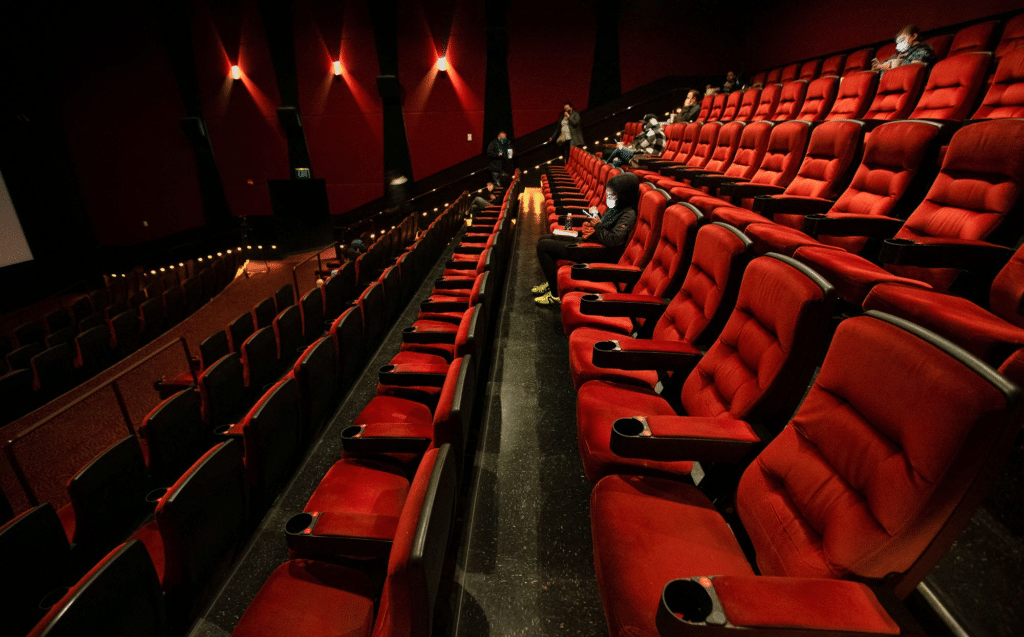What film you’re seeing and even your seat location may soon determine the price you pay
Paramount’s “80 for Brady” did decently on a rather quiet weekend for the box office, but beneath its $12.5 million opening weekend is one of several experiments that could change how much moviegoers pay for tickets based on what day they buy a ticket, what movie they’re seeing and even where they sit in the theater.

For the entirety of its theatrical run, tickets for all screenings of “80 for Brady” at national chains AMC, Cinemark and Regal will be sold at matinee prices. That exact price varies depending on location, but according to exhibition sources the average ticket price for “80 for Brady” was $9.79, about 21% less than the $12.30 average ticket price for the weekend’s No. 1 film, Universal’s “Knock at the Cabin.”
Meanwhile, AMC announced a pilot program called Sightline Monday, which will be introduced by the chain at select locations and introduce different prices for tickets depending on seating.
While “Knock at the Cabin” edged out “80 for Brady” by an opening weekend count of $14.2 million to $12.5 million, “80 for Brady” sold approximately 200,000 more tickets than “Knock.” That’s what Paramount’s president of domestic distribution Chris Aronson is counting on, even if it means a little less money initially added to the bottom line.
“The more bodies we can get in the door to see our picture, the better off we’ll be not just in the primary window but in secondary windows like home release as well,” Aronson said. “I believe this pricing scheme got more bodies in the door and will continue to do so as the theatrical run continues.”

Movie theaters have long had discounts for matinee and midweek screenings as they tend to have lesser turnout compared to evening screenings on Thursdays through Saturdays, but Aronson has been a vocal champion of a dynamic pricing model that offers cheaper tickets for films that aren’t the franchise blockbusters that make up the overwhelming majority of today’s box office.
As Aronson argues, lowering the ticket prices on crowd-pleasing films like “80 for Brady” that attract older moviegoers — films that have been generally successful in the past year, but few in number — can increase the audience buzz for those films and not only allow them to leg out better, but help raise their profile when they’re released for home rental and streaming. He has made this case at multiple industry events, including the movie theater trade show CinemaCon and in panels hosted by the International Cinema Technology Association.
With its early February release slot, appeal to older audiences and the studio only on the hook for distribution and marketing costs, “80 for Brady” was seen by Paramount as the perfect film to try experimenting with dynamic pricing.
“The one thing that kept coming back in our focus groups of older moviegoers is that they want to see movies that reflect their life, but they also want value,” Aronson said. “We showed this to our exhibition partners and presented this as an opportunity to really promote a movie to a section of the audience that has been slower to come back in the past year at a bargain price and they pretty much agreed.”
While it’s still early in the film’s run, insiders at two theater chains said they were pleased by the opening weekend results for “80 for Brady” and are optimistic that admissions will remain robust in the coming weeks.
“In the past year, we’ve seen theater chains show a greater willingness to try out more bargain prices to see if they can attract more moviegoers and still work financially,” said Boxoffice editor Daniel Loria. “We’ve already had chains do discount days in the middle of the week, but AMC pushed it further by dropping Tuesday discount prices to $5 in January. We will have to look closely at AMC’s next earnings call to see how these experiments continue.”
But those experiments aren’t just about offering discounts. Under AMC’s Sightline, while most seats will still be sold at traditional prices, seats in the middle of the auditorium will be sold at premium prices, while seats in the front rows and in select ADA sections will be sold at lower prices. Participating AMC locations will use Sightline for all screenings after 4 p.m. with the exception of Tuesdays where $5 discount prices will still be in effect for all screenings.
In the press release announcing the program, AMC chief marketing officer Eliot Hamlisch said that Sightline was designed to make moviegoing similar to ticket pricing for live entertainment venues.
“While every seat at AMC delivers an amazing moviegoing experience, we know there are some moviegoers who prioritize their specific seat and others who prioritize value moviegoing,” he said. “Sightline at AMC accommodates both sentiments to help ensure that our guests have more control over their experience, so that every trip to an AMC is a great one.”
Of course, Sightlines also gives AMC a chance to draw extra revenue from the most prime seats in an auditorium, something that they also tried last year with dollar surcharges for opening weekend screenings of major blockbusters such as “The Batman,” similar to the ones levied on screenings in premium formats like 3D and Imax. While dynamic pricing can encourage someone on the fence about seeing a lesser known film to give it a try if the tickets are cheaper, it’s also designed to make more money from the films that are seen by millions as event releases that have to be seen immediately to avoid spoilers.
In both cases, there will need to be several months of experimenting before any conclusions can be drawn about whether dynamic pricing is working. In terms of matinee pricing for “80 for Brady,” the benchmark of success will likely be whether the film can do as well or better than similar films that cater to older audiences. Last fall, Universal’s “Ticket to Paradise,” starring George Clooney and Julia Roberts, opened to $16.5 million and legged out to $68.2 million in North America, while Sony’s “A Man Called Otto” starring Tom Hanks has grossed $53 million after five weekends in wide release.
A similar result for “80 for Brady” while drawing a higher admissions count would be evidence that the dynamic pricing model can draw more eyes to non-franchise films as Aronson and Paramount want, but it will probably take films from other genres to convince theaters and other studios that it can be common practice.
That’s because while marketing for the matinee pricing may have raised interest among older audiences in “80 for Brady,” those audiences tend to go to matinee screenings anyway and not to the evening screenings where the discount is actually in effect. Exhibitor Relations analyst Jeff Bock said that the next step for dynamic pricing should be to test it on a film that could get a larger foothold among the younger crowd that shows up for blockbusters, but not so much for smaller films.
“I think what Paramount is doing is a great idea and every studio should be looking at what films they could test it on. Any genre that hasn’t been performing as well as it used to should be on the table,” Bock said. “’80 for Brady’ is a comedy, so why not try it with a comedy for younger audiences? We’ve talked for years about how straight comedy films don’t work at the box office anymore, so offering those films at a discount when they get released may be a good way to get audiences to give them a try again.”
Insiders at rival studios have said they don’t have any immediate plans to work with theater chains on cheaper prices for one of their films, but will be monitoring “80 for Brady” to see how it performs in the coming weeks as an alternative to younger-skewing films like “Ant-Man and the Wasp: Quantumania” and “Cocaine Bear.” While one executive who spoke anonymously said he’s not entirely sold on dynamic pricing having a significant effect on moviegoing interest, he believes that “Brady” has the potential to leg out over the next month.
“Bottom line is, Paramount made a movie that is fun for older audiences. Yes, seniors love a good bargain, but the movie’s gotta work,” the exec said. “For me, the takeaway for Hollywood from this isn’t about the pricing but about how we need to make more movies that are fun. ‘Top Gun’ and ‘Elvis’ were fun, and so is this film.”




